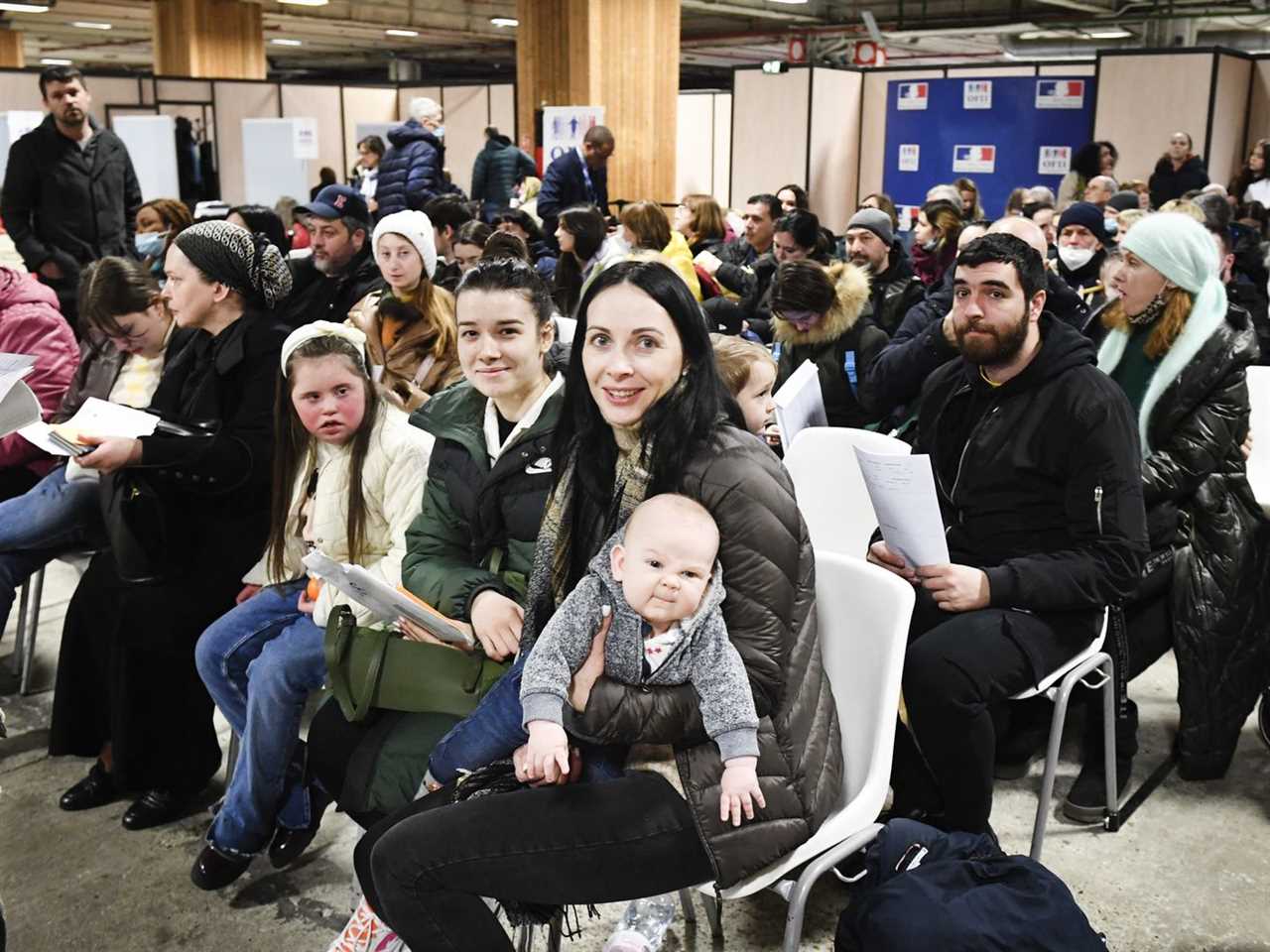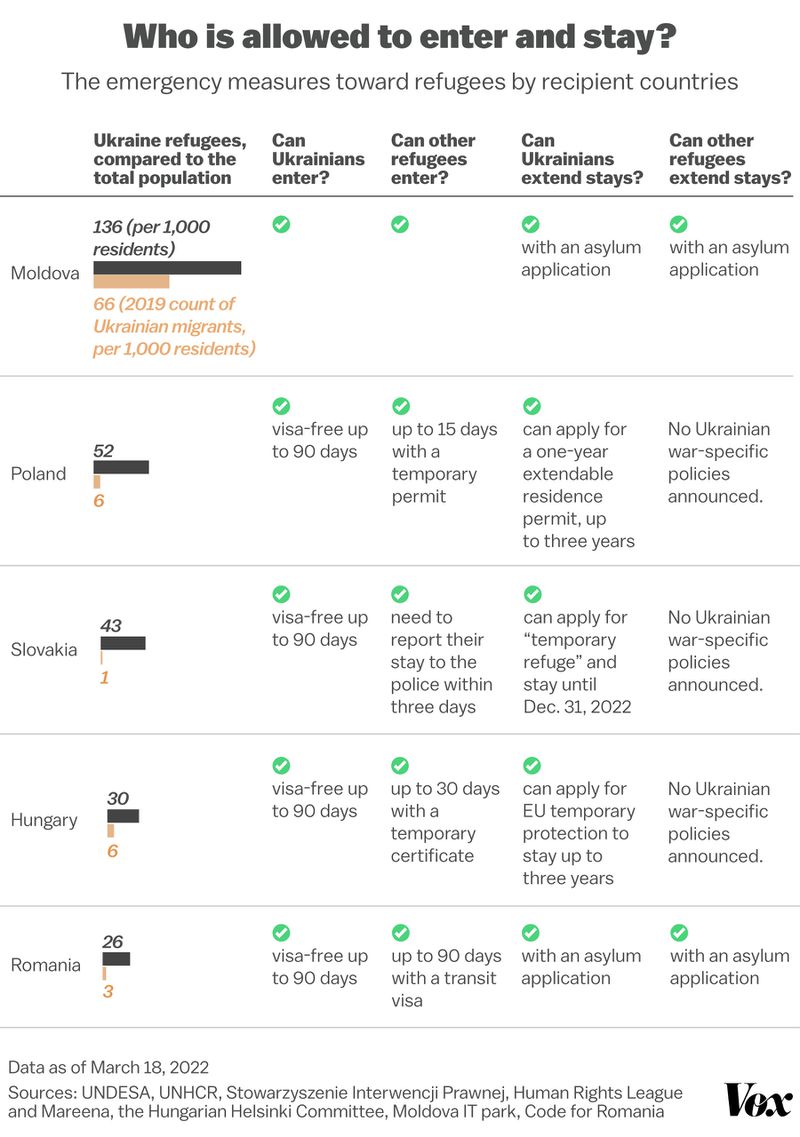
Data shows why Ukrainian refugees are being treated differently than others fleeing violence.
More than 3 million people have fled Ukraine in the weeks since the start of Russia’s invasion. Europe hasn’t seen an exodus of this scale and speed since World War II. Equally unprecedented is the welcoming attitude that countries neighboring Ukraine have had toward these refugees.
Race, culture, and religion certainly play a role in the warm welcome fleeing Ukrainians have received. But recent history is another factor. Though Ukraine isn’t part of the European Union, the ease with which Ukrainians have been able to work and travel to EU countries have made them fixtures in the bloc, and that — perhaps even more than geography — has contributed to a sense that they are Europeans currently in need of aid from other Europeans.
In the weeks since the start of the invasion, all of Ukraine’s borders except those with Russia and Belarus have remained open. Most refugees used one of the 31 border checkpoints in western Ukraine and entered Poland, Slovakia, Hungary, Romania, and Moldova. Poland took the majority, close to 2 million as of March 18.

The governments of these nations — and non-governmental groups — quickly worked out emergency plans to help those fleeing the Russian invasion. The EU announced on March 4 that Ukrainian citizens (who, pre-war, didn’t need a visa to stay up to 90 days in the EU territory) would be entitled to the newly enacted temporary protection directive —permitting them to live, work, and study in EU member states for up to three years.
The exact implementation may differ from country to country, and some plans may still shift. For the five neighboring countries that opened borders to let Ukrainians in, all except Moldova are EU members.

Non-Ukrainians, however, didn’t get the same rights or legal protection. In the first few days of Russia’s invasion, there were incidents in which Ukrainian citizens were allowed to cross the border while non-Ukrainians faced obstacles to doing so. Now, at least on paper, people can cross the border regardless of nationality. Poland issues a 15-day temporary permit, Romania a 90-day transit visa, and Hungary a 30-day residence permit to non-Ukrainians. Officials expect them to go back to their home countries before those permits expire, or apply for asylum if they wish to stay longer.
The disparity between how Ukrainian and non-Ukrainian refugees are being treated is stark. It brings to the fore longstanding debates about what makes someone European, and who is worthy of Europe’s protection. It’s also key to understanding why Ukrainians have been met with open arms by the rest of Europe.
Why refugees from Ukraine have been treated differently
European countries haven’t seen such a large number of displaced people in this short period of time in recent history. It took three weeks for 3 million to leave Ukraine. While at least a couple hundred thousand Ukrainians have returned home, that’s still an overwhelmingly fast flow of people. When 3 million Syrians fled their country due to the war, it took two years to reach that milestone, and an even longer time for Syrian refugees to reach Europe.
To put the size of the population fleeing Ukraine into perspective, nearly 6 million people applied for asylum in European Union countries from 2013 to 2021. About 2.5 million sought asylum during 2015 and 2016.
Syrian refugees saw a very different reception than the Ukrainians currently fleeing Russia’s assault have — one that’s more reminiscent of the welcome non-Ukrainians have received, and consistent with the experiences other refugees of color have faced when trying to reach Europe. Hungarian Prime Minister Viktor Orbán called arriving migrants fleeing the Syrian war a Muslim invasion in 2015 and built border walls to fence them off. Last October, Poland entered a state of emergency when thousands of refugees from Afghanistan and Iraq attempted to cross the border from Belarus into the European Union.
Polls across the EU reflect a deep wariness about certain immigrants. Generally, European countries are less welcoming to immigrants of races and ethnicities that differ from their predominantly white populations. And people in eastern European countries, including Slovakia, Hungary, and Poland, are less likely to think immigrants should be allowed in than their western counterparts, according to the latest European Social Survey, conducted across the bloc in 2018.
A push to repatriate refugees has led to efforts like Denmark working to send its Syrian refugees from Damascus back home. Across Europe, far-right parties have expanded their power, both in individual nations and the EU parliament, partially on an anti-immigration platform.
The different treatment toward Ukrainian refugees is rooted in a sense that, although Ukraine isn’t in the EU, its citizens are European. People from European countries see themselves in the Ukrainian refugees fleeing the war. That has been clear from their public statements, including those tinged with racist and xenophobic ideas about what it means to be European.
“These people are Europeans,” Bulgarian Prime Minister Kiril Petkov said. “These people are intelligent. They are educated people. ... This is not the refugee wave we have been used to, people we were not sure about their identity, people with unclear pasts, who could have been even terrorists.”
While refugees from Middle Eastern, African, or Asian countries are seen as “others,” the geographic proximity, similar skin colors and religions, as well as the social-economic ties to the EU states all contribute to the identification of Ukrainians as “us” — Europeans.
An increasingly unified European identity has formed among the eastern European countries that joined the EU in the 2000s. Most citizens of Poland, Hungary, Slovakia, and Romania see themselves as citizens of the European Union.
While Ukrainians aren’t EU citizens, they have enjoyed visa-free travel in the EU member states since 2017. By 2020, they were the third-largest group of non-EU citizens living in the bloc, behind citizens of Morocco and Turkey.
Before the war, most Ukrainians in the EU came for work. More than half of Ukrainian migrants residing in the EU got their residence permits through work. In 2020, 86 percent of the Ukrainians who applied for residence permits for the first time received their permits for employment-related reasons, the highest among all other nationals.
Ultimately, Ukrainians want their country to join the EU. Four days into the war, Ukraine’s President Volodymyr Zelenskyy submitted an application for EU membership, an act then mirrored by former Soviet states Moldova and Georgia. The EU application and linkage processes take a long time, and western members of the bloc have rebuffed Ukraine’s request to fast-track its approval. But after years of roadblocks, the path is “open for them to take.”
----------------------------------------
By: Youyou ZhouNicole NareaChristina Animashaun
Title: Europe’s embrace of Ukrainian refugees, explained in six charts and one map
Sourced From: www.vox.com/22983230/europe-ukraine-refugees-charts-map
Published Date: Sat, 19 Mar 2022 12:00:00 +0000






